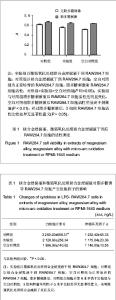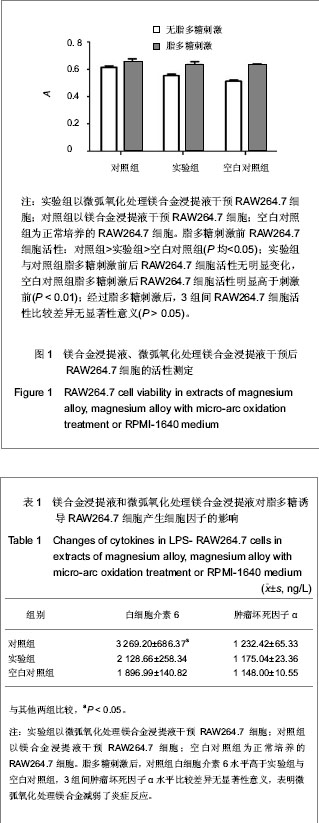| [1] Hummel M,Czerlinski S,Friedel N,et al.Interleukin-6 and interleukin-8 concentrations as predictors of outcome in ventricular assist device patients before heart transplantation. Crit Care Med.1994;22(3):448-454.[2] Li XX,Tang M,Deng XL,et al.Shijie Keji Yanjiu yu Fazhan. 2010; 32(6):832-834.李晓霞,唐明,邓旭亮,等.国产无机三氧化物聚合物的免疫相容性研究[J].世界科技研究与发展,2010,32(6):832-834.[3] Witte F,Kaese V,Haferkamp H,et al.In vivo corrosion of four magnesium alloys and the associated bone response. Biomaterials.2005;26(17): 3557-3563.[4] Witte F,Hort N,Vogt C,et al.Degradable biomaterials based on magnesium corrosion.Curr Opin Solid State Mater Sci.2008; 12(5-6):63.[5] Wang YP,Yin ZF,Jiang Y,et al.Zhonghua Linchuang Yishi Zazhi. 2011;5(24):7323-7326.王勇平,尹自飞,蒋垚,等.镁合金材料在医学临床领域的应用[J].中华临床医师杂志,2011,5(24):7323-7326.[6] Zhu XW,Han JM,Cui SH,et al.Cailiao Kexue yu Gongyi. 2006; 14(4):366-369.祝晓文,韩建民,崔世海,等.铝、镁合金微弧氧化技术研究进展[J].材料科学与工艺,2006,14(4):366-369.[7] Li LQ,Xi JJ,Yao XY.Hanjie. 2008;52(5):15-18.李利群,袭建军,姚英学.钛合金微弧氧化技术的研究[J].焊接, 2008,52(5):15-18.[8] Zhang ZY,Zhao Q,Liu YE.Diandu yu Tushi. 2008;27(5):30-34.章志友,赵晴,刘月娥.镁合金微弧氧化工艺及陶瓷层耐蚀性能研究[J].电镀与涂饰,2008,27(5):30-34.[9] Hu HL,Gao NN,Yu YC,et al. Diandu yu Tushi. 2009;28(12): 34-36.胡会利,高宁宁,于元春,等.镁合金表面微弧氧化陶瓷膜的形成过程研究进展[J].电镀与涂饰,2009,28(12):34-36.[10] Li GJ,Li L,Xu CQ.Cailiao Re Chuli Jishu. 2008;37(18):94-98.李贵江,李亮,许长庆.镁合金微弧氧化陶瓷膜层研究进展[J].材料热处理技术,2008,37(18):94-98.[11] Deng SH,Yi DQ,Gong ZQ,et al. Cailiao Kexue yu Gongyi. 2007; 15(1):22-25.邓姝皓,易丹青,龚竹青,等.镁合金微弧氧化膜的制备工艺研究[J].材料科学与工艺,2007,15(1):22-25.[12] Waksman R,Pakala R,Baffour R,et al.Short-term effects ofbiocorrodible iron stents in porcine coronary arteries.J Interv Cardiol.2008;21(1):15-20.[13] Waksman R,Erbel R,Di Mario C,et al.Early and long term intravascular ultrasound and angiographic findings after bioabsorbable magnesium stent implantation in human coronary arteries.JACC Cardiovasc Interv.2009;2(4):312-320.[14] Erbel R,Di Mario C,Bartunek J,et al. Temporary scaffolding of coronary arteries with bioabsorbable magnesium stents: a prospective, non-randomised multicentre trial. Lancet.2007; 369(9576):1869-1875.[15] Li Z,Gu X,Luo S,et al.The development of binary Mg-Ca alloy for use as bio degradable materials within bone.Biomaterials. 2008;29(10): 1329-2344.[16] Pietak A,Mahoney P,Dias GJ,et al.Bone-like matrix formation on magnesium and magnesium alloys.J Mater Sci Mater Med. 2008;19(1): 407-415.[17] Witte F,Ulrich H,Palm C,et al.Biodegradable magnesium scaffolds: Part Ⅱ: peri-implant bone remodeling.J Biomed Mater Res A.2007;81(3): 757-765.[18] Witte F,Ulrich H,Rudert M,et al.Biodegradable magnesium scaffolds: Part I: Appropriate inflammatory response.J Biomed Mater Res A.2007;81(3): 748-756.[19] Huang Z,Wu FM,Liu LX,et al.Kouqiang Yixue. 2009;29(4): 180-182.黄震,吴凤鸣,柳麟翔,等.微弧氧化AZ91D 镁合金对成骨细胞早期粘附的影响[J].口腔医学,2009,29(4):180-182.[20] Buchanan JB,Sparkman NL,Johnson RW.Methamphetamine sensitization attenuates the febrile and neuroinflammatory response to a subsequent peripheral immune stimulus.Brain Behav Immun.2010;24(3):502-511. [21] Buchanan JB,Sparkman NL,Johnson RW.A neurotoxic regimen of methamphetamine exacerbates the febrile and neuroinflammatory response to a subsequent peripheral immune stimulus. J Neuroinflammation.2010;7:82-92.[22] Tipton DA,Legan ZT,Dabbous MKh. Methamphetamine cytotoxicity and effect on LPS-stimulated IL-1β production by human monocytes.Toxicol In Vitro.2010;24(3):921-927. [23] Wang C,Deng L,Hong M,et al.TAK1 is a ubiquitin-dependent kinase of MKK and IKK.Nature.2001;412(6844): 346-351.[24] Akira S,Uematsu S,Takeuchi O. Pathogen recognition and innate immunity. Cell.2006;124(4):783-801.[25] Keshet Y, Seger R.The MAP kinase signaling cascades: a system of hundreds of components regulates a diverse array of physiological functions.Methods Mol Biol.2010;661:3-38.[26] Xu L,Pan F,Yu G,et al. In vitro and in vivo evaluation of the surface bioactivity of a calcium phosphate coated magnesium alloy.Biomaterials.2009;30(8):1512.[27] Shang W,Chen BZ,Shi XC,et al.Cailiao Yanjiu Xuebao. 2011; 25(1):57-60.尚伟,陈白珍,石西昌,等. 镁合金微弧氧化一溶胶凝胶复合膜层的耐蚀性[J].材料研究学报,2011,25(1):57-60.[28] Sun W,Zhang GD,Tan LL,et al.Zhongguo Zuzhi Gongcheng Yanjiu. 2012;16(21):3907-3910.孙伟,张广道,谭丽丽,等. 钙磷涂层镁合金植入体周围组织中骨形成蛋白2的表达[J].中国组织工程研究, 2012,16(21): 3907-3910.[29] Wang SF,Li CR,Wang CY,et al.Zhongguo Zuzhi Gongcheng Yanjiu.2012;16(38): 7101-7106.王树峰,李春荣,王程越,等. 微弧氧化AZ31镁合金的生物相容性[J]. 中国组织工程研究, 2012,16(38): 7101-7106.[30] Majumdar DJ,Bhattacharyya U,Biswas A,et al. Studies on thermal oxidation of Mg-alloy(AZ91)for improving corrosion and wear resistance.Surf Coat Techn.2008;202:3638.[31] Song YW,Shan DY,Han EH. Electrodeposition of hydroxyapatite coating on. AZ91D magnesium alloy for biomaterial application.Mater Lett.2008;62(17):3276.[32] Wang J,Meng B,Zhou NX,et al.Zhonghua Gandan Waike Zazhi. 2004;10(12): 841-843.王敬,孟波,周宁新,等.可降解聚乳酸支架在胆管损伤治疗中作用的实验研究[J].中华肝胆外科杂志,2004,10(12): 841-843.[33] Zhang J,Zong Y,Fu PH,et al.Zhongguo Zuzhi Gongcheng Yanjiu yu Linchuang Kangfu. 2009;13(29):5747-5750.张佳,宗阳, 付彭怀,等.镁合金在生物医用材料领域的应用及发展前景[J].中国组织工程研究与临床康复, 2009,13(29): 5747-5750.[34] Miao B,Jiang DZ.Mudanjing Yixueyuan Xuebao. 2009;30(2): 28-30.苗波,姜德志. 不同涂层镁合金兔下颌骨植入的生物相容性研究[J]. 牡丹江医学院学报,2009,30(2): 28-30.[35] Laskin DL,Pendino KJ. Macrophages and inflammatory mediators in tissue injury.Annu Rev Pharmacol Toxicol.1995; 35(9):655-677.[36] Shi L,Fang Y,Yuan WF,et al.Guoji Huxi Zazhi. 2009;29(13): 772-776.石榴,方怡,袁伟锋,等.脂多糖刺激RAW264.7和Ana-1形态改变及细胞因子表达的差异[J].国际呼吸杂志,2009,29(13): 772-776. |

